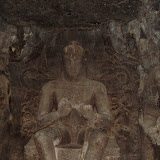A year or so ago I was in Thiruvanathapuram with a friend of mine. It was an unplanned trip, we had decided only a couple of days earlier that we would go some place, so we hadn't done any research and were mostly improvising (we started in Kochi and went all the way down to Kanyakumari). The locals enthusiastically recommended the Anantha Padmanabhaswamy temple as a 'must see', so we put it on our list.
I classify temples into two kinds: one, temples which are of artistic and historic importance and are worth seeing even if one is a non-believer. I put the temples in Hampi, Pattadakal (both in Karnataka), Konark, the Jain temples around Mt. Abu, etc., in this category. Two, temples which are, for the most part, popular as abodes of powerful gods, but do not hold much interest for the non-believer apart from the contemporary socio-cultural phenomena that these temples represent. For the non-believer in this case, it is not the temple itself, but the masses that come on pilgrimage, and their faith in the god who resides there, that is significant. I put the temples at Tirupati, Haridwar, Shirdi, etc., in this category.
Now, we weren't sure which of these two categories the Padmanabhaswamy temple fit into, and we didn't particularly want to go to a temple where the only thing to do was to get a darshan; so, we arrived at the temple with a fair amount of doubt that this was going to be a complete waste of time. The rules of entry, we found, were strict, and quite conservative: photography wasn't allowed, non-Hindus weren't allowed entry, men weren't allowed to wear anything above the waist, and no one was allowed to wear clothes that display the two legs separately. So, we bared our chests, and wore hired lungis (sarongs) to cover our legs.
We finally entered the temple and started looking around. It took us some time to register what was different about what we were seeing: sculptures of dancers and such is the norm in temples, so it is no wonder that it took us so long. But these were not merely sculptures of dancers, these were very explicit erotic sculptures, and the temple was full of them; and these weren't tame either, I learnt a few things about sex that I didn't know from them. My friend opined that this probably was done to encourage procreation, and that newly weds might have been taken around the temple. My speculation was more cynical: patrons of devdasis provided for the priests and the temple, and this might have been done to stimulate the patrons.
In any case, while that was interesting in itself, it wasn't what intrigued us the most: it was the people around us, they didn't look the least bit bothered by the sculptures. Mind you, if this were some European museum, I might have taken a different view, but this was an Indian temple, and these were the same people that are outraged at the smallest hint of sexual explicitness in public, whether in real life, art or even film. But here they were, kids and all, behaving like they would in any other temple. And that's when I realised it: they weren't actually registering anything unusual. They came to the temple to see their god, and that is what they saw. All the other activities that go with a visit to the temple, doing pradakshinas, taking prasad, having a peaceful sit down while eating it and so on were similarly done following the usual routine. They weren't interested in the sculpture, and unless someone specifically pointed it out to them, they wouldn't notice it as anything other than another generic sculpture (Heidegger comes to mind here). Of course I am generalising, I am sure a few people notice it everyday, I am just stating my general perception.
Not sure of my read on the situation, I looked to the internet for information on the Padmanabhaswamy temple. Not one mention of the erotic sculptures: not in the Wikipedia entry, nor in any other popular entries I found. On the other hand, the beautiful idol of lord Vishnu in the sanctum sanctorum is described in great detail in all these entries. Hence my point: the purpose of a temple in contemporary Indian society is set, that is its state of being, and anything pertaining to the temple outside that purpose is not even perceived for it to be written about. And given the restriction on access to only Hindus, and the prohibition of photography, there is no outside perspective to shed light on what is not being perceived (contrast with Konark and Khajuraho where photography as well as non-Hindus are allowed).
P.S:
I did consider the alternative where actually everyone is noticing the sculptures, but no one is talking about it. But, the usual reaction in that case, I think, is a feeling of awkwardness (in India, that is), and a general avoidance of the subject all together. But that is not that case here, people recommend the temple quite openly, and talk about its greatness.
My visit to the Jagannath temple at Puri last week (july, 2011) strengthens my claim. Erotic sculpture at Puri is of the same style as of that at Konark. But, as with the Padmanabhaswamy temple, only Hindus are allowed in the temple complex, and photography is not allowed. So, while erotic sculpture at Konark - less than 30 km away from Puri - is discussed in great detail in published books, that at Puri is not even mentioned. All the more surprising given that the Sun temple at Konark is heavily damaged, a lot of the sculpture losing its form, while the sculpture at Puri is in pristine condition.




